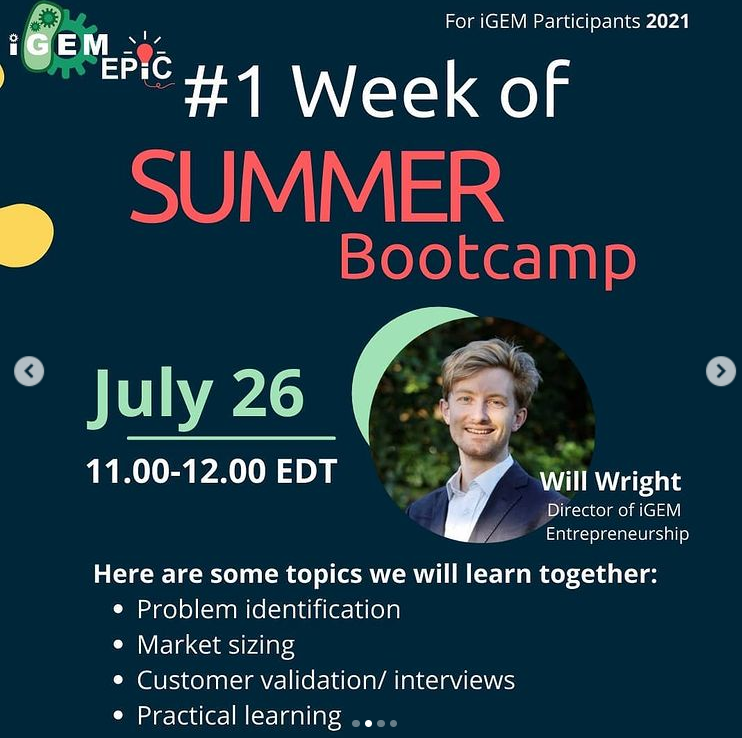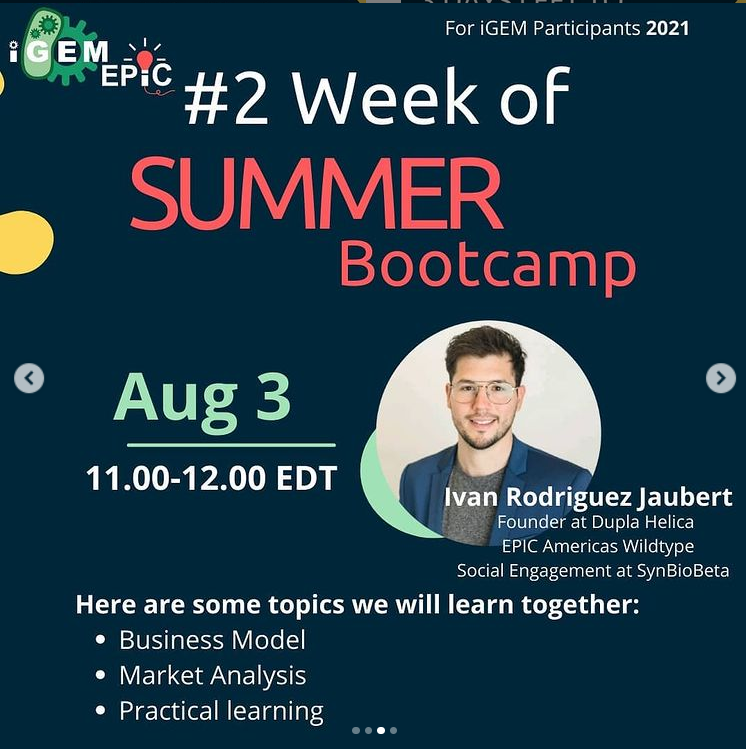“The area of application for functional biofilms is increasing steadily. However, it is possible that pathogens invade those biofilms. This could pose a risk for the environment and humans. A system which is able to target those pathogens specifically and eliminate them reliably could help to make the use of biofilms more secure and attractive.”
Prof. Dr. Fabian Commichau (Expert of synthetic microbiology)
Inspiration
In the beginning of our project, there was the vision of iGEM: Building a better world with synthetic biology. While the world of SynBio is thriving and a lot of new tools and technologies are emerging, there has always been the need to evaluate safety and security. This is especially important to avoid creating additional hazards out of new technologies.
Such new dangers are particularly feared by the general public. This is reflected in our public survey we performed as part of our Ethics & Policies work. Here, only 5% of the 365 participants associated “synthetic biology” with the term “safe”. In contrast, 44% of participants see risks in SynBio (Figure 1).

Therefore, we made it our mission to enable a safer and more feasible application of SynBio tools. Since we dealed with this issue to a greater extend we created a seperate Safety and Security page. Here, our reflections and elaborations are displayed further. We want to realize this not only for stakeholders and scientists, but also for the general public, so they no longer need to fear SynBio. This will lead to more acceptance by the public and drive the progress of SynBio in the future. As a result, fears such as those shown in Figure 2 below will fade into the background.

Defining our Project
We used a self-developed algorithm to search for keywords in every iGEM project description of the last six years in order to find insights into emerging technologies. In many wikis, we came across one prominent keyword: Biofilm.

As shown in Figure 3, the percentage of iGEM Teams that mentioned biofilms shows a growing trend in recent years. In 2020, 10% of all teams mentioned biofilms in their project wiki, which is double the amount of the previous year. Overall, there is a clear trend noticeable. We then analyzed in more detail some of the projects that aim at the application of functional biofilms. Indeed, we found several great examples like the iGEM Team Harvard 2017 with the synthesis of biochemical products in biofilms1 or last year’s team Groningen with the protection of plant roots via biofilms2. In 2019, team William and Mary engineered biofilms as living materials that should be applied in wound healing or water treatment.3
Last year’s team from the TU Darmstadt developed a drug degrading Bacillus subtilis biofilm for wastewater treatment. A problem of that project was that the engineered biofilm probably needed a protection layer due to its fitness disadvantages compared to unmodified bacteria. Last year, our team knew there was the threat of invading pathogens, this year we are eradicating these worries and make SynBio safer. Therefore, we finally decided to implement our system in B. subtilis cells and build upon our own project from 2020!4
Advantages of B. subtilis and Biofilms
Since B. subtilis is well researched and “generally regarded as safe” (GRAS)5,6, it is possible to use this organism safely in the laboratory by young researchers as iGEMers are. Besides of safety aspects the usage of B. subtilis as host organism has other benefits as well. For example, B. subtilis is regarded as a “universal cell factory” as it has a highly efficient secretion system for proteins.7 With this, it can synthesize and secrete enzymes as well as large proteins even on an industrial scale.5
Moreover, biofilms and especially B. subtilis biofilms have a great advantage over free bacterial cells. Due to their extracellular matrix, the cells are held together and can thus be protected from harsh conditions. Such biofilms can be engineered to find application for medical implants, biosensors, and drug delivery systems, as all of these applications can utilize the secretion system of B. subtilis, if required.5,6
Besides, not only the iGEM community focuses with increasing interest on the usage of biofilms. Currently, many papers are published regarding biofilm-based applications, e.g., in fermentation processes or living materials. Dong Liu and Yong Chen from Nanjing Tech University pointed out that “biofilms could provide favorable conditions for the growth of cells during industrial fermentation”.8–10 Chen Zhang from ShanghaiTech University, China described that “biofilms have an unparalleled potential”.5
Current research also deals a lot with B. subtilis biofilms in particular. These can be engineered into “living glue” to take advantage of dynamic biological processes only living cells can perform. For example, this can find application in medicine as a “biofilm band aid” on wounds.5 Furthermore, B. subtilis biofilms are engineered to produce living materials, which makes biological systems like biofilms usable for new applications.9
Improving Biofilm Safety
The various implementations of previous iGEM Teams as well as of current scientists show how diverse functional biofilm applications can be. However, before safe implementation of these new technologies can be achieved precautions have to be considered. Functional biofilms contain useful and harmless bacteria but for example when used for wastewater treatment, pathogens can invade these biofilms. Moreover, they can coexist or even conquer the useful biofilm. While in the biofilm, these pathogens are protected from detection and more importantly from eradication with common methods, e.g., antibiotics. This can cause severe health problems since those pathogens can thrive unhindered within the biofilms. That is why pathogens that enter the biofilm must be destroyed without harming the biofilm itself to ensure a safe use of functional biofilms. Therefore, we developed our phage defense system that detects and eradicates invading pathogens through highly specific bacteriophages. And thus, only bacteria releasing the phages which are those in proximity to the pathogen are damaged.
The proposed implementation of our system is co-culturing of our engineered sleeper cells with the original cells of the biofilm. By that, the biofilm is made self-defensive against pathogens. We first designed such a responding system against Pseudomonas aeruginosa, which is one of the critical pathogens identified by the WHO11 and causes nosocomial infections such as pneumonia.12 However, our vision is to engineer various types of sleeper cells that respond to different pathogens and create a multi-functional and safe biofilm.
In order to enable a modular application of our system, one sleeper cell should only carry the genome of one highly specialized bacteriophage that targets one specific pathogen. In doing so, the metabolic burden on the B. subtilis sleeper cells is reduced. By combining various types of sleeper cells our multi-functional B. subtilis biofilm should respond to different pathogens. As one part of our proof of concept, we were able to develop a successful method to generate a co-cultured biofilm consisting of two different B. subtilis strains. To facilitate an easy way for other researchers, iGEM Teams, or stakeholders to use our system, we provide a detailed protocol and software concept for the generation of a multi-functional biofilm.
Conclusion
Potential future customers just need to acquire the desired B. subtilis sleeper cells responding to the presence of a specific pathogen with the expression of phages. These B. subtilis sleeper cells are then co-cultured with the functional B. subtilis cells. This enables the formation of a safe and functional biofilm. To get a closer look at our project as a possible product, we attended the iGEM EPIC Summer Bootcamp. You can read more about the insights we acquired in the section below. This should enable us to implement PHIRE BYRD in the real world.
iGEM EPIC Summer Bootcamp
The Summer Bootcamp was hosted by iGEM EPIC (Entrepreneurship Program Innovation Community), which supports the development of an entrepreneurial community as part from the iGEM competition itself. The program supports young scientists in evolving their iGEM projects further with the ultimate goal to become a start-up.
The Bootcamp consisted of three one-hour sessions and targeted current iGEMers. It imparted the basics of what makes an entrepreneurial iGEM project and explained the requirements of the Supporting Entrepreneurship Prize. Additionally, the Bootcamp pointed out how teams or individuals can continue their entrepreneurial journey with the support of iGEM EPIC.

The Bootcamp provided us with fundamental techniques, which are not only crucial in the means of entrepreneurship, but also for developing our project and the story behind it. Especially the first two sessions were a huge support, since they helped us with the identification of the problem we want to solve and in the next step, to identify our target group as well as analyze and size the market we approach. For further information, check out our Project Description!
References
- 1. iGEM Harvard 2017 Project Description. iGEM Harvard. 2017 [accessed 2021 Oct 8]. https://2017.igem.org/Team:Harvard/Description
- 2. iGEM Groningen 2020 RootPatch Protecting Plants Conversing Biodiversity. iGEM Groningen. 2020 [accessed 2021 Oct 7]. https://2020.igem.org/Team:Groningen/Description
- 3. iGEM William and Mary. 2019. Project Description. Abstract. iGEM William and Mary. 2019 [accessed 2021 Oct 7]. https://2019.igem.org/Team:William_and_Mary/Description
- 4. iGEM TU Darmstadt. 2020. Overview. Project Description. iGEM TU Darmstadt. 2020 [accessed 2021 Oct 7]. https://2020.igem.org/Team:TU_Darmstadt/Description#Project%20description
- 5. Zhang C, Huang J, Zhang J, Liu S, Cui M, An B, Wang X, Pu J, Zhao T, Fan C, et al. Engineered Bacillus subtilis biofilms as living glues. Materials Today. 2019:40–48. http://dx.doi.org/10.1016/j.mattod.2018.12.039. doi:10.1016/j.mattod.2018.12.039
- 6. Huang J, Liu S, Zhang C, Wang X, Pu J, Ba F, Xue S, Ye H, Zhao T, Li K, et al. Programmable and printable Bacillus subtilis biofilms as engineered living materials. Nature Chemical Biology. 2018:34–41. http://dx.doi.org/10.1038/s41589-018-0169-2. doi:10.1038/s41589-018-0169-2
- 7. Su Y, Liu C, Fang H, Zhang D. Bacillus subtilis: a universal cell factory for industry, agriculture, biomaterials and medicine. Microbial Cell Factories. 2020. http://dx.doi.org/10.1186/s12934-020-01436-8. doi:10.1186/s12934-020-01436-8
- 8. Ren P, Chen T, Liu N, Sun W, Hu G, Yu Y, Yu B, Ouyang P, Liu D, Chen Y. Efficient Biofilm-Based Fermentation Strategies by eDNA Formation for l-Proline Production with Corynebacterium glutamicum. ACS Omega. 2020:33314–33322. http://dx.doi.org/10.1021/acsomega.0c05095. doi:10.1021/acsomega.0c05095
- 9. Liang C, Ding S, Sun W, Liu L, Zhao W, Zhang D, Ying H, Liu D, Chen Y. Biofilm-based fermentation: a novel immobilisation strategy for Saccharomyces cerevisiae cell cycle progression during ethanol production. Applied Microbiology and Biotechnology. 2020:7495–7505. http://dx.doi.org/10.1007/s00253-020-10770-1. doi:10.1007/s00253-020-10770-1
- 10. Chen T, Liu N, Ren P, Xi X, Yang L, Sun W, Yu B, Ying H, Ouyang P, Liu D, et al. Efficient Biofilm-Based Fermentation Strategies for L-Threonine Production by Escherichia coli. Frontiers in Microbiology. 2019. http://dx.doi.org/10.3389/fmicb.2019.01773. doi:10.3389/fmicb.2019.01773
- 11. Tacconelli E, Magrini N. Global priority list of antibiotic-resistant bacteria to guide research, discovery, and development of new antibiotics. WHO. 2017 [accessed 2021 Oct 17]. https://www.who.int/medicines/publications/WHO-PPL-Short_Summary_25Feb-ET_NM_WHO.pdf
- 12. Mena KD, Gerba CP. Risk Assessment of Pseudomonas aeruginosa in Water. Reviews of Environmental Contamination and Toxicology Vol 201. 2009:71–115. http://dx.doi.org/10.1007/978-1-4419-0032-6_3. doi:10.1007/978-1-4419-0032-6_3





